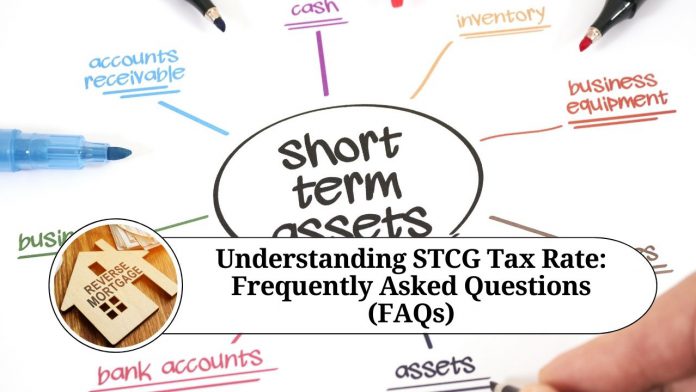Short-term Capital Gains (STCG) tax rate is a tax that is levied on the profit made from selling or transferring short-term capital assets. The tax rate on STCG is different from that on long-term capital gains (LTCG) and is determined based on the nature of the asset and the period of holding.
In this blog, we will explore STCG tax rates and their implications.
What is Short-term Capital Gains Tax?
Capital assets are classified as either short-term or long-term, depending on the holding period. Assets that are held for less than 12 months are considered short-term, while assets held for more than 12 months are considered long-term.
STCG tax is levied on the gains made from the sale of short-term capital assets such as shares, mutual funds, bonds, and property. The tax is calculated as the difference between the selling price and the cost of acquisition of the asset.
STCG tax is applicable only if the gains made on the sale of the asset exceed the exemption limit set by the government. For the financial year 2021–2022, the exemption limit for STCG tax is Rs. 1 lakh.
STCG Tax Rate
The STCG tax rate is based on the nature of the asset and the tax slab applicable to the taxpayer. The tax slab applicable to the taxpayer is determined based on their total income for the financial year.
For equity shares and equity-oriented mutual funds, the STCG tax rate is 15%. However, if the gains are below the exemption limit of Rs. 1 lakh, no tax is applicable.
For debt-oriented mutual funds, the STCG tax rate is the same as the taxpayer’s tax slab. For example, if the taxpayer falls in the 20% tax slab, the STCG tax rate will also be 20%.
For other short-term capital assets, such as property and bonds, the STCG tax rate is the same as the taxpayer’s tax slab.
It is important to note that the STCG tax rate is different from the LTCG tax rate, which is 10% for gains above the exemption limit of Rs. 1 lakh.
Implications of the STCG Tax
The STCG tax rate can have significant implications for investors and traders. Short-term trading or speculation in the stock market can lead to significant STCG tax liabilities, reducing the overall return on investment.
As a result, investors may choose to focus on long-term investments to reduce their tax liability. Additionally, investors may also choose to offset their STCG tax liability by taking advantage of tax-saving instruments such as ELSS (Equity Linked Savings Scheme) and PPF (Public Provident Fund).
STCG Tax Rate on Equity Shares and Equity-Oriented Mutual Funds
For equity shares and equity-oriented mutual funds, the STCG tax rate is 15% of the gains made on the sale of the asset. However, if the gains are below the exemption limit of Rs. 1 lakh, no tax is applicable. This means that if the profit made on the sale of the asset is less than Rs. 1 lakh, no STCG tax needs to be paid.
It’s important to note that equity-oriented mutual funds are those that have at least 65% of their portfolio invested in equity shares. If a mutual fund does not meet this requirement, it is considered a debt-oriented mutual fund.
STCG Tax Rate on Debt-Oriented Mutual Funds
For debt-oriented mutual funds, the STCG tax rate is the same as the taxpayer’s tax slab. This means that the tax rate can vary from 5% to 30%, depending on the total income of the taxpayer. As with equity shares and equity-oriented mutual funds, the exemption limit for STCG tax on debt-oriented mutual funds is Rs. 1 lakh.
STCG Tax Rate on Other Assets
For other short-term capital assets, such as property and bonds, the STCG tax rate is the same as the taxpayer’s tax slab. This means that the tax rate can vary from 5% to 30%, depending on the total income of the taxpayer. Again, the exemption limit for STCG tax on these assets is Rs. 1 lakh.
Offsetting STCG Tax Liability
One way to offset STCG tax liability is by taking advantage of tax-saving instruments such as Equity Linked Saving Schemes (ELSS) and Public Provident Fund (PPF). ELSS is a type of mutual fund that invests in equity shares and has a lock-in period of three years. Investment in ELSS is eligible for a tax deduction under Section 80C of the Income Tax Act, 1961. Similarly, PPF is a long-term investment option that offers tax benefits under Section 80C.
Conclusion
STCG tax is an important factor to consider for investors and traders, especially those who engage in short-term trading or speculation. It’s important to understand the STCG tax rate for different types of assets and the implications of the tax on overall returns. By taking advantage of tax-saving instruments and long-term investments, investors can reduce their STCG tax liability and improve their overall returns.
Read more useful content:
- section 234e of income tax act
- section 286 of income tax act
- section 90a of income tax act
- section 40a(7) of income tax act
- section 226(3) of income tax act
- section 24 of income tax act
Frequently Asked Questions (FAQs)
Q:1 What is the STCG tax rate?
STCG tax rate is the tax levied on the profits made from selling or transferring short-term capital assets. The tax rate varies depending on the nature of the asset and the period of holding.
Q:2 How is STCG tax calculated?
STCG tax is calculated as the difference between the selling price and the cost of acquisition of the asset. The tax rate is then applied to the gains made on the sale of the asset.
Q:3 What is the difference between STCG tax and LTCG tax?
The main difference between STCG tax and LTCG tax is the period of holding of the asset. STCG tax is applicable on short-term capital assets held for less than 12 months, while LTCG tax is applicable on long-term capital assets held for more than 12 months. The tax rates for STCG and LTCG also differ.
Q:4 What is the STCG tax rate for equity shares and equity-oriented mutual funds?
The STCG tax rate for equity shares and equity-oriented mutual funds is 15%. However, if the gains are below the exemption limit of Rs. 1 lakh, no tax is applicable.
Q:5 What is the STCG tax rate for debt-oriented mutual funds?
For debt-oriented mutual funds, the STCG tax rate is the same as the taxpayer’s tax slab. This means that the tax rate can vary from 5% to 30%, depending on the total income of the taxpayer. The exemption limit for STCG tax on debt-oriented mutual funds is also Rs. 1 lakh.
Q:6 What is the STCG tax rate for other short-term capital assets such as property and bonds?
The STCG tax rate for other short-term capital assets such as property and bonds is the same as the taxpayer’s tax slab. This means that the tax rate can vary from 5% to 30%, depending on the total income of the taxpayer. The exemption limit for STCG tax on these assets is also Rs. 1 lakh.
Q:7 How can I reduce my STCG tax liability?
One way to reduce STCG tax liability is by taking advantage of tax-saving instruments such as Equity Linked Saving Schemes (ELSS) and Public Provident Fund (PPF). These investments offer tax benefits and can help reduce the overall tax liability. Additionally, investors can focus on long-term investments to avoid short-term capital gains tax altogether.




















